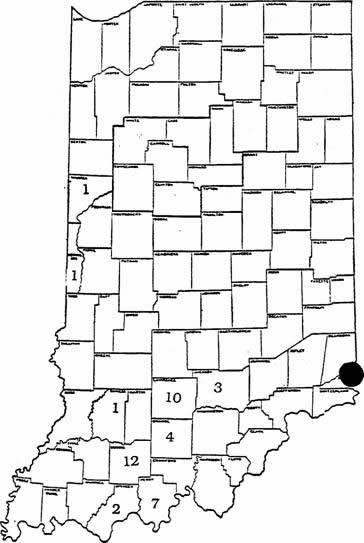Epizootic Hemorrhagic Disease in Indiana
Epizootic Hemorrhagic Disease (EHD) is a fatal disease
of white-tailed deer that occasionally affects cattle, but
not sheep. The disease in cattle is either subclinical or
mild and usually manifests as oral erosions not specific
to any particular part of the oral cavity, lameness with
no obvious lesions on the feet, and erosions on teats and
udder in severe cases. EHD resembles the disease caused
by the Bluetongue virus (BTV). Both viruses are in the same
genus, Orbivirus, and may cross react in diagnostic testing.
When these lesions are seen, EHD and BTV are primary, differential
diagnoses.
During the summer of 1996, 44 cattle seropositive for EHD
were located in nine Indiana
counties. The distribution of the cases is shown in Figure
1. Most of the cases have occurred in the lower one third
of the state. Reported lesions are oral and teat ulcers,
and a severe lameness with no obvious lesions on the feet.
Cattle are usually affected for 7-10 days and then recover
regardless of treatment. Most of the cases have been reported
in cows six to ten years-of-age, although calves have tested
positive. Both sexes and all breeds can be affected, although
beef cattle are the majority of the cases that have been
seen in Southern Indiana. Of the
44 cases reported, only three animals have died which is
consistent with bovine death losses reported in the literature.
Since the virus is transmitted by the biting midge, Culicoidesvariipennis,
the incidence of the disease should decrease as the weather
becomes colder.
On agar gel immunodifiusion tests (AGID), EHD and BTV cross
react. Of the 44 seropositivecases, 22 tested positive for
BTV as well as EHD on AGID, although the BTV results were
usually weakly positive. Five of these 22 serum samples
were sent to NVSL in Ames,
Iowa for serum neutralization;
all five were negative for BTV and positive for EHD. When
AGID gives a positive result for BTV, serum neutralization
can be performed for a definitive diagnosis.
White-tailed deer are reservoirs for EHD; however,
to this date, no wild deer have tested positive. Four captive
deer have tested positive in Gibson, Sullivan,Dubois, and
Daviess counties. Two of the four deer were dead at the
time of testing.
- by Kara L. Nelson, Class of 1997
- edited by Wm. Van Alstine,DVM,PhD
References:
Metcalf, H.E.,Luedke, A.J. and Jochim, M.M.:
"Epizootic Hemorrhagic Disease Virus Infection in Cattle"
in Bluetongue, African Horse Sickness and Related Orbiviruses,edsWalton,
T.E. and Osburn, B.I.,CRC Press Inc.BocaRaton, Florida,
1992, p. 222.
Osburn, B.I.,Arabaib, I.E. and Schore,C.E.:"Comparison
of Bluetongue and Epizootic Hemorrhagic Disease Complex",
Bovine Pract, 1995, 29:109.
Incidence of EHD in Cattle in IndianaFrom
8/9 to 9/23

Figure 1
|